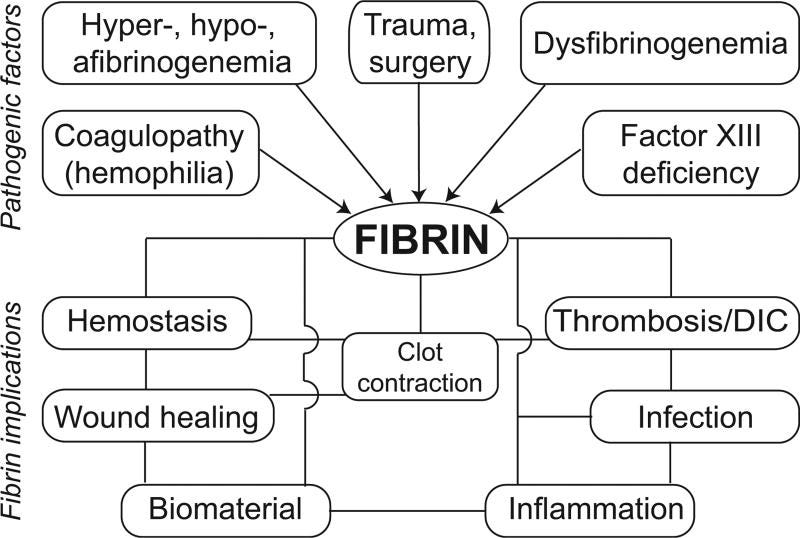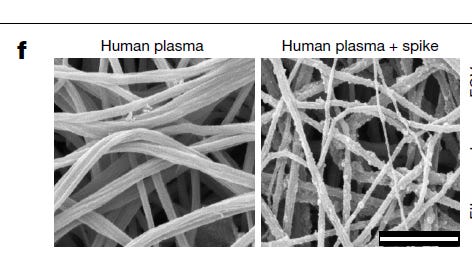Brainwashed scientists from UCSF published a paper accidentally explaining the white fibrous clots found by morticians in mRNA vaccine victims worldwide.

Oct 17, 2024
First a note of gratitude for the notes from paid subs. I can’t answer each and every one, so I am going to say it here – thank YOU! I am reading your notes and I very much appreciate your support. Writing this substack is a full time job. Art is an after hours job. And I love it, or I wouldn’t be doing it. Your messages are inspiring and telling me I should continue, and I will.
A recent paper from UCSF published in Nature, despite efforts of the authors to cover up mRNA vaccine injury, revealed some very interesting findings. It may potentially explain those huge rubbery clots that are being pulled from the deceased vaccine victims by morticians, and on occasion have been extracted from people who are still alive.
Here is an excellent article discussing “People’s Blood Clot Survey” with harrowing statistics about these clots:
Results of the People’s Blood Clot Survey as of October 1, 2024
NOTE TO FIRST TIME READERS AND/OR NEW SUBSCRIBERS…
9 days ago · 53 likes · 35 comments · Laura Kasner
These clots are not assembled from the contents of the vials, but only “ignited” by them as will be explained below. There is not enough volume of the injectable to account for such large structures, so these clots contain accumulated human tissue for the most part.
Major findings from the USCF study:
- Fibrin and fibrinogen bind to the spike protein and form proinflammatory blood clots.
- Clots drive systemic thrombo-inflammation, micro- and macro-clotting & brain pathology.
- Loss of natural killer (NK) cells is seen & explains increase in cancer.
Some basic facts about fibrin and fibrinogen:
Fibrin and fibrinogen are two closely related proteins that play a crucial role in blood coagulation and hemostasis. Fibrinogen is synthesized in the liver, in hepatocytes. Fibrinogen is present in normal blood in high concentrations but lies dormant until activated, typically in response to a vascular injury. The subsequent cascade produces fibrin. Fibrin is required when there is injury to blood vessel walls, a foreign substance in the body (e.g., an injected toxic mRNA concoction) and/or through activated cells.
Formation of fibrin clots in vivo, their size, and location, as well as fine structure and properties are greatly influenced by several variable pathogenic factors shown in the upper part of the cartoon below. The biological and clinical relevance of fibrin is determined by its implications in the vital interconnected patho (physiological) reactions and processes:

In the process of fibrin formation, fibrinogen is cleaved into fibrin monomers (single strands) which assemble into a tough insoluble matrix of fibers that coagulates blood which forms a clot. This is normally a reversible reaction. The body can dissolve fibrin clots through a series of enzymatic reactions after the wound has healed and the clot is no longer needed.
More recently, fibrin has been used as a versatile biomaterial, particularly in surgical applications as a sealant, gel, cellular matrix, scaffolding, etc. This is because some permanent structures can be made out of it, as long as the dissolution of fibrin is prevented by the prosses of cross-linking.
This scientific review paper about fibrin states that:
Fibrin formation is naturally reversible but the fibrin network can be made permanent through crosslinking with various other polymers [14]. The fibrin clot that is crosslinked yields a stronger clot mechanically, with higher stability and resistance to breakdown by the body. Fibrin clots also generally attract and bind to various plasma proteins in the body. Some examples include actin, cadherin, albumin and interleukin-1β among others.
In chemistry and biology, a crosslinking is formation of bonds or a short sequences of bonds that links one polymer chain to another. When polymer chains are crosslinked, the material becomes more rigid.
Would spike protein count among these “plasma proteins” that bind and crosslink with fibrin, forming a permanent, non-dissolvable fibrous clot? Methinks it’s highly likely!
Lo and behold, that’s exactly what the UCSF study published in Nature found. Fibrin-fibrinogen-spike interaction in clot formation:

The picture is worth a 1000 words. You can see the spikes bound into fibrin, creating sticky points, and crosslinks, leading to permanent fibrous structures, that can no longer be dissolved by the body. I added emphasis and annotations in the below quote from the UCSF study:
We next tested whether spike interferes with the polymerization, degradation and inflammatory properties of fibrin. Incubation of spike with healthy donor plasma in the presence of thrombin, which is elevated during COVID-19 [read – mRNA injection], resulted in altered clot structure shown by scanning electron microscopy (SEM) and increased turbidity of fibrin clot formation (Fig. 1f,g and Extended Data Fig. 3a–c). Incubation of spike with fibrin delayed plasmin degradation of both the β-chain and the γ–γ dimer (Fig. 1h), suggesting that spike delays fibrinolysis. These findings are consistent with the formation of dense fibrin clots with thin fibres in thromboembolic diseases and fibrinolysis-resistant blood clots in patients with COVID-19 [read – in mRNA vaccine victims].
So, these guys from UCSF found that the spike (ONLY FROM “DA VIRUS”, I SWEAR!!) activates fibrin formation, then binds and polymerizes the fibrin into permanent, non-dissolvable structures. Lovely. This might explain those embalmer clots, seems like a plausible mechanism to me.
What if this happens in the brain? Or, even better – in the testicles of the vaxxed clowns from UCSF who wrote this paper (I am sure they gulped a few times when looking at their own results). Not good. Not good at all:
Increased BBB permeability associated with parenchymal fibrin deposition is a feature of COVID-19 neuropathology8,9. In the brain of some patients with COVID-19, detection of spike and viral RNA suggests potential neuroinvasion41,45.
By now you all know to replace “covid-19” with “mRNA injections” while reading propaganda journals like Nature, right?
Our data and previous literature support that, while spike can enhance fibrin toxicity, even in the absence of spike, fibrin is deleterious in diseases such as multiple sclerosis, Alzheimer’s disease, rheumatoid arthritis, colitis and periodonditis15,18,19,20. Thus, fibrin may be deposited either together with spike when spike is present in the brain45 or through an open BBB after peripheral infection without neuroinvasion or spike coupling.
Among other goodies from injecting mRNA and/or spike in LNP they also found that fibrin suppresses “natural killer” (NK) cells that are supposed to keep cancer in check. So, are we shocked that mRNA-induced turbo cancer is out of control?
The fibrin-induced suppression of NK cells that we observed is consistent with enhanced cancer cell survival in vitro after co-culture with fibrin-stimulated NK cells48, suggesting a role for fibrin in other diseases with vascular damage and impaired NK cell cytotoxicity, such as cancer and autoimmune diseases49.
Conclusion from UCSF study:
These results suggest a fibrin-dependent mechanism that elicits inflammatory and oxidative stress responses in the presence of spike in the absence of active infection, which could therefore have a role in long COVID.
In other words, the authors conclude that spike protein, circulating in the blood in the absence of “active covid infection” is responsible for clotting and fibrin crosslinking. What is the spike doing in the blood when there is no “infection”? It’s like saying, there was a shark in these waters 2 years ago, he left and we haven’t seen him again, but the teeth, man! They swim and multiply now all by themselves… We must call it the Long Shark Syndrome, otherwise Nature will ban us… Let’s think hard about this… Think harder…. Oh! I know! It’s when the spike and numerous vectors for it are injected into the blood stream by a needle, isn’t it, that’s when we arrive at this highly unfortunate situation.
But of course, the acadummies from UCSF must never think such unauthorized thoughts. They immediately plead that this clearly vaccine-induced scenario is not vaccine induced:
Notably, we do not believe that this mechanism is related to the rare clotting complications observed with adenovirus based COVID vaccines because the production of anti-PF4 autoantibodies and ensuing drop in platelet counts are triggered by the vector rather than spike36.
Well… maybe just a little bit true. “Small amount”… “accumulate locally” and then swiftly eliminated… and unlike those BAD spikes, these are GOOD spikes, see, the BAD ones make crosslinked fibrin clots, but the GOOD ones make you go to heaven:
In general, COVID-19 RNA vaccines lead to small amounts of spike protein accumulating locally and within draining lymph nodes where the immune response is initiated and the protein is eliminated37. Consistent with the safety of the spike mRNA vaccines, mRNA vaccines prevent post-COVID-19 thromboembolic complications38 and a cohort study in 99 million COVID-vaccinated individuals showed no safety signals for haematological conditions39.
It’s hard to be an acadummy-scientist these days: you have to twist into illogical pretzels, but anyone with a non-smooth brain can see you are just a pathetic small-money whore.
Art for today: The Sheep, watercolor, 9×12 in.

Due Diligence and Art is a reader-supported publication. To receive new posts and support my work, consider becoming a free or paid subscriber.
Leave a Reply